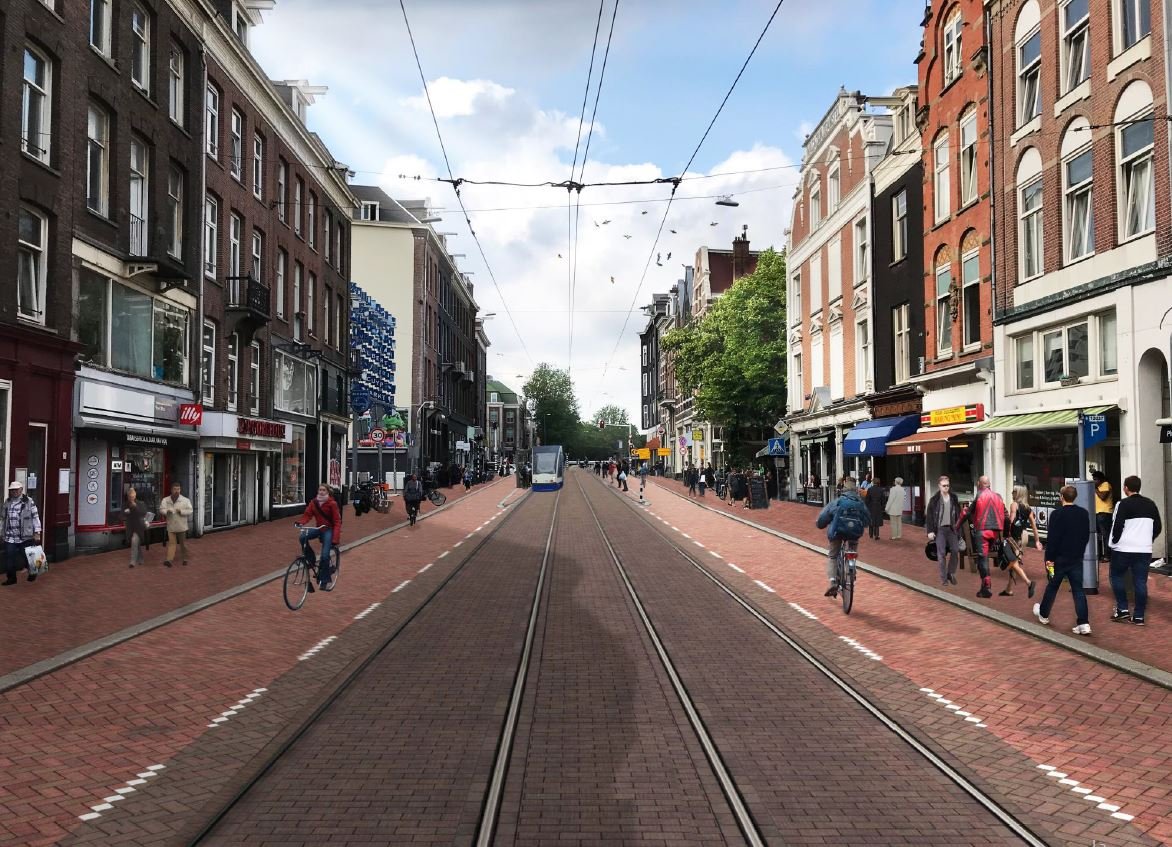Challenge: How to improve Amsterdam’s worst street for cyclists?
Ask any Amsterdam cyclist which street he or she considers worst to cycle in, and 9 out of 10 will name Van Woustraat. Particularly in the narrow northern region, you could discern how unnerving and stressful cycling was. An example of how bad cycling felt in many streets between the 1970s and 80s. Read more about the obstacles in Van Woustraat and how difficult it is to find solutions. And read about the promising plan to finally make Van Woustraat safe and pleasant for cyclists.
Stressful cycling in Van Woustraat
Van Woustraat has always been an important route from the centre of the city to the south of Amsterdam. On the route, there are high numbers of pedestrians, cyclists, trams, cars (driving and parking) and shops; all of which must find a place on narrow 20 meters (m) wide street.
When there were few cars, a 20m wide street was feasible. However, when the number of cars increased from the 1950s, spatial problems arose. Parking restrictions were implemented in the first place to guarantee the traffic flow of trams.

| Parking restrictions in Van Woustraat in 1966. Photo: Stadsarchief Amsterdam
Due to the growing numbers of cars, cycling became difficult and dangerous in Van Woustraat. Cyclists had to deal with busy and chaotic traffic whereby the bicycle rider frequently had to swerve over the tram tracks when cars were double-parked. This is evidently a tricky manoeuvre as bicycle wheels can get stuck in the tram tracks.

| Stressful cycling in chaotic Van Woustraat. Photo: Stadsarchief Amsterdam, 1983
Demonstrating for better cycling in Van Woustraat
In the 1970s there were series of bicycle demonstrations known as “Amsterdam Fietst!”. In 1977, cyclists protested for better safety in Van Woustraat.

| Cyclists protesting for better safety in Van Woustraat, and in the rest of the city. Photo: Archive Fietsersbond Amsterdam, 1977
Since the 1980s, many main roads in Amsterdam have been redesigned following the Sustainable Road Safety guidelines. Though, that of Van Woustraat is yet to be accomplished.
To really improve the narrow Van Woustraat, there should be fewer cars, both driving and parking along the road. Taking out parking places has always been difficult as a result of shop owners worried about loss of customers that travel by car.
Small measures help a little
Consequently, only relatively small measures were taken over the years. In order to prevent the most dangerous encounters car parking is forbidden during rush hour. Although this ban has been disputed several times by shop owners it was successfully defended by the Cyclists’ Union.
In 2015 the speed limit was lowered to 30km/h and parking was forbidden close to the side streets. This only had little result as the problem in Van Woustraat is not so much the speed, but the chaotic traffic in limited space.

| Stressfull cycling in Van Woustraat, and difficult to cross. Photo: Marjolein de Lange, 2015
Major adjustments require bold choices
Finally, in 2018 the city started to develop a more effective plan. The plan was based upon studies into challenges and possibilities of the street and elaborate consultation with residents, road users and shop owners. In 2019, our city council approved a concept plan that includes the removal of all the parking places and prohibition of cars driving from the north into the street. The plan still needs to be worked out in detail.

| Impression of future Van Woustraat. Image: City of Amsterdam
The prohibition of cars and removal of all parking places has implications for the whole neighbourhood. More studies and consultations are needed before the final decision can be made. More information can be found here.
An important argument is that taking out the parking places and reducing the number of cars makes Van Woustraat not only better for cyclists but also for pedestrians and children. And finally, the narrow public space of Van Woustraat will improve.
A relic
The renovation of the northern part of Van Woustraat is planned to start by the end of 2021. Until then Van Woustraat can be seen as a relic of how nerve-racking cycling along most Amsterdam streets used to be in the 1970s.
Lessons learnt
Even in Amsterdam there are still bike unfriendly streets, where improvements for cyclists need long term endurance and persistence.
Our questions
Does your town faces challenges like we have in Van Woustraat? How does your city work on improvements? Share your thoughts, examples, and ideas via Disqus below.









